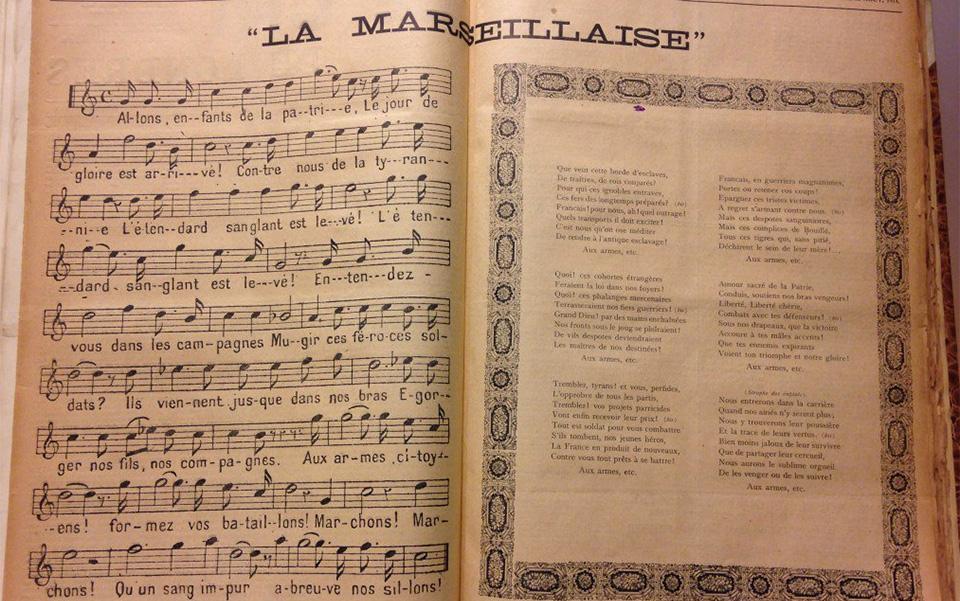Research finds WW1 French and Belgian refugees were branded ‘shirkers’ in the UK and faced similar pressures to today’s immigrants
Primary page content
French and Belgian nationals who fled to Britain during the First World War triggered similar reactions to immigrants who come to the UK today, according to new research.

The Marseillaise (Le Cri de Londres, 22 August 1914)
The Francophone newcomers led to fears that parts of Britain were becoming overpopulated and also to concerns that British tradespeople were being undercut by newly-arrived workers. Some refugees were branded “shirkers” for avoiding the war, historians say.
But research using both English and Francophone newspapers of the era does reveal one undoubted economic benefit: the hotel industry saw a boom thanks to the influx 100 years ago.
The findings were discovered by historians at Goldsmiths, University of London who worked with 20 London school pupils to explore the stories of French-speaking migrant and refugee communities across the UK including London.
Conducting original research with sources from the British Library that had previously been unexplored by historians, the researchers studied the worlds of both refugee and permanently settled communities in the capital, and the interactions between these groups and the British.
According to the 1911 census, there was an established community of around 23,000 French and Belgian nationals living in London. In the years following the outbreak of the First World War, some 250,000 refugees came to the UK– of which 95% were Belgians.
Local newspapers provided a treasure trove of information about the refugees.
According to the Folkestone, Hythe, Sandgate and Cheriton Herald newspaper, Kent was the second home of the French in 1914. One article from September 1914 headlined “Our populous district” stated that Folkestone was “abnormally populated”.
But it went on to say that while this could have led to an accommodation crisis it actually proved to be a boon to local guesthouses. The article adds: “Some of the hotels have little to complain of in the amount of patronage which they have enjoyed during the past month or so.”
Another article in the newspaper highlights the economic impact of the immigrants. It appears that many British tradespeople felt that their services were being undercut by Belgian and French refugees.
The Exeter and Plymouth Gazette in January 1915 was struck by the number of young, male refugees – and called on them to take up arms in their homelands.
The newspaper said: “We are rendering assistance to a great number of young Belgian lads who are shirkers, and who ought to be properly in the fighting line instead of walking about streets of London with their hands in the pockets.”
Research was led over 10 months by Dr Charlotte Faucher, working with Professor Richard Grayson, both from the Department of History at Goldsmiths.
They also discovered that the established French community in London engaged very little with the newcomers despite their shared language.
As part of an outreach programme Dr Faucher worked alongside 20 students and staff at the Lycée français Charles de Gaulle in South Kensington and NewVIc 6th Form College in Newham.
Professor Grayson said: “It's amazing how far some of the debates about refugees in 1914-18 are exactly the same at those we are having in the UK and rest of the EU today.
You could delete 'French' or 'Belgian' from the stories and insert 'Syrian' and people would think the comments had been made today.
"The project has been a tribute to the benefits of academics and schools working together, with Dr Charlotte Faucher's expertise being a major driver of the work, combined with the enthusiasm of the schools and their pupils."
Dr Faucher said: “The pupils and myself were surprised to see how distinct the 18,000 French and 5,000 Belgian established in London before 1914 remained from the Belgian and French refugees who arrived in Britain after 1914. Although the established Francophone community did set up some charitable schemes and schools to help refugees, the two communities had very few daily interactions.
“We worked with pupils aged 11 to 18 from West and East London. French is the mother tongue of most of them but they all had different family histories and experiences of migration so they came up with very varied approaches to the topic which made our sessions extremely stimulating.”
“Business A-Level students from NewVic did great archival work studying advertisements for French shops and products published in the Francophone press during the war. The students showed that there is great continuity within London-based French business before and during the war.
“Pupils at the Lycée Francais Charles de Gaulle were keen to discover more about the origins of their school which opened in 1915. They were surprised to find that the Lycée was first created to school Belgian refugees. There was actually a very small percentage of French nationals schooled at the Lycée in 1914-1918.”
“One hundred years later, things are very different indeed and 82% of the 4,000 pupils enrolled at the school are French. Many historians stress the fact that Belgian refugees did not leave a trace in Britain...perhaps one exception to this is the lycée?”
The project will be launched at Goldsmiths, University of London on 22 September 2016 with students from the two schools taking part in a tour of Goldsmiths’ campus to gain an insight into university life.
An exhibition based on the research will travel to several locations in Britain, France and Belgium and a bilingual blog about the project has also been created: https://ww1francophonesinlondon.wordpress.com
The project was funding by Gateways to the First World War (and Arts and Humanities Research Centre public engagement project) and the Mission Centenaire 14-18, a body run by the French government.